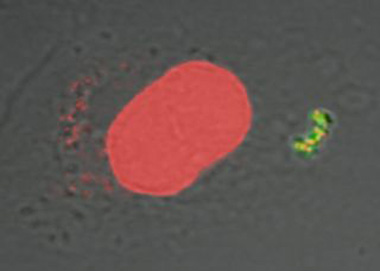TCD Scientists Discover A New Way of Detecting Invading Viruses
Posted on: 04 October 2010
Scientists at Trinity College Dublin have discovered a new way that the immune system is alerted to invading viruses inside cells, by using a protein called ‘IFI16’ to sense the presence of viral DNA. The findings have just been published in the leading international journal, Nature Immunology, and arose from a Science Foundation Ireland-funded project led by Professor Andrew Bowie of the School of Biochemistry and Immunology in TCD. The lead researchers on the project were TCD scientists Dr Leonie Unterholzner, Dr Sinead Keating and Marcin Baran, while the work involved important collaborations with the University of Massachusetts Medical School, the University of Aarhus, Denmark and the National Institutes of Health, Maryland.
During a viral infection, invading viruses infiltrate cells and attempt to hijack the cells own replication machinery in order to produce new viral particles. The immune system therefore needs to be able to detect the presence of viruses inside the cytosol, which is the main intracellular compartment, in order to fight back and turn on the body’s anti-viral defences. One such anti-viral defence involves the production of proteins called interferons, which shut down infected and surrounding cells in order to contain the virus. Interferons get produced when the immune system is alerted to the presence of viral DNA in the cytosol. While it has been known for some time that the cytosol contains viral DNA sensors that stimulate interferon production, very few of these sensors have been identified.

Protein, IFI16, appears beside viral DNA in the cytosol.
The TCD scientists set out to find new DNA sensors, by using a piece of viral DNA as bait in order to fish out proteins from the cytosol that would stick to DNA, and therefore may act as immune sensors. These DNA-binding proteins were identified by mass spectrometry. In this way they established a shortlist of possible candidates, which was narrowed down to just a few proteins by examining which ones were present in increased amounts during a viral infection. This allowed them to hone in on IFI16, a protein already known to have a function in the nucleus, but not thought to be present in the cytosol, let alone be involved in detecting viruses there. Nonetheless further experiments showed that IFI16 appeared right beside viral DNA in the cytosol, and that it controlled the cellular signaling circuits known to stimulate interferon production. When the amount of IFI16 in cells was experimentally reduced, those cells then failed to respond properly to DNA-containing viruses and mount an interferon response. Together these results showed that IFI16 is critical to the ability of cells to respond to invading DNA-containing viruses.
In addition to increasing our understanding of how we detect viruses, the discovery of IFI16 may also have more far reaching implications. DNA sensing in the cytosol is also known to turn on an interferon response to bacteria that invade cells such as Listeria, while some autoimmune diseases such as lupus are thought to be initiated by accidental sensing of human DNA by the immune system. Thus using drugs to manipulate IFI16’s DNA sensing function may eventually have therapeutic value in both infectious diseases and in autoimmunity.
Commenting on the significance of the research findings, Professor Bowie said: “We are very excited by the discovery of IFI16 as a DNA sensor as it represents a critical missing piece in our understanding of how the immune system detects invading viruses inside our cells.”
Trinity in the News:
